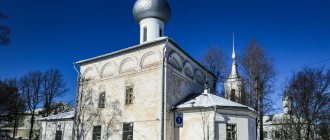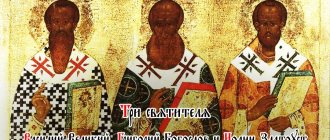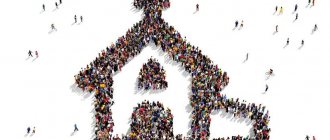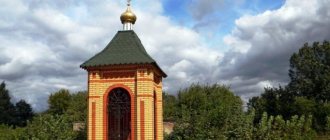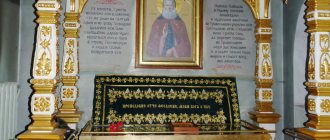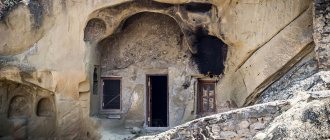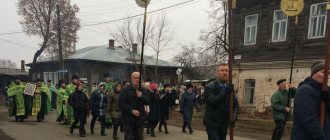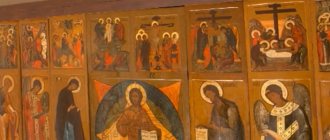- Description
- Trips here (2)
Description of the Church of the Three Saints in Kulishki
The Church of the Three Saints on Kulishki is an Orthodox church of the Epiphany deanery of the Moscow city diocese.
The temple is located in the Basmanny district, Central Administrative District of Moscow (Khitrovsky Lane, corner of Maly Trekhsvyatitelsky Lane). The main altar of the lower church was consecrated in honor of the ecumenical teachers and saints, the chapel in honor of Florus and Laurus; the upper church is in the name of the Holy Trinity.
The Church of the Three Saints is located in the historical district of Moscow, which used to be called Kulishki. “Kulishki” (more correctly kulizhki) is an old Russian word, interpreted differently by different sources. Among the possible meanings you can find a swampy, swampy place and a forest after felling. The ancient district of Kulishki was located at the confluence of the Moscow River and the Yauza River. Currently, this is the Solyanka area with adjacent lanes to Yauzsky Boulevard and the Yauza embankment and the entire territory of the former Orphanage.
The terrain here was very picturesque. In the center of the area there was a hill, which was crossed by the Rachka River (in the 18th century it was hidden in a pipe). In the 15th century, Vasily I built his summer palace here with a house church, consecrated in the name of St. Prince Vladimir, currently known as the Temple of St. Vladimir in Old Sadekh. The famous princely gardens with luxurious fruit trees were laid out on the slopes of the hill. The sovereign's stables were located next to the gardens. A wooden church was built in the equestrian yard in the name of the holy martyrs Florus and Laurus, who were revered by the people as patrons of horses. After the construction of the Moscow Metropolitan's country house next to the stables (in Trekhsvyatitelsky Lane), a home metropolitan church in the name of the Three Ecumenical Hierarchs was added to the Church of Florus and Laurus.
In the 16th century, the grand ducal estate was moved to the village of Rubtsovo-Pokrovskoye, due to the fact that the southeastern part of the White City began to be actively populated. Churches that were previously located in residences became parish churches, and churchyards were formed at them. The network of streets and alleys that developed at that time has been preserved to this day. The entire hill was named “Ivanovo Hill” in honor of the monastery founded here in the name of the Nativity of John the Baptist.
In 1674, a new stone church was built at the expense of parishioners. The temple building was made two-story, placing the bell tower on the corner. Warm chapels were located on the lower floor - Trekhsvyatitelsky from the south and Florolavsky from the north. The upper unheated part of the temple was consecrated in honor of the Holy Life-Giving Trinity.
The location of the church was very successful - at the top of Ivanovskaya Hill. The facades of the temple were decorated with patterned platbands and portals, high porches led to the upper floor, and the apses of warm aisles arranged in a row ended with ploughshare-covered domes.
Subsequently, in the 18th-19th centuries, the temple building was rebuilt several times.
In 1927, the temple was closed and its building was transferred to Myasnitskaya prison. Church valuables were taken away, and the locally revered icon of the Mother of God “Epiphany of the Eyes” disappeared. The temple building was beheaded, and the bell tower tent was also demolished.
In the 1930s, the building was transferred to the NKVD. After the addition of the 4th floor, the temple building was turned into a communal apartment.
In the 1950s, the fence was destroyed.
In the 1960s, the building was used for various offices. At the same time, VOOPIiK began its restoration. Architect-restorer A. I. Okunev decided to recreate the original appearance of the temple. The bell tower on the corner, the domes, and the decoration of the facades of the 17th century were restored. The surviving part of the second bell tower reminds of later reconstructions.
Since 1987, the animation studio “Pilot” has been located in the temple building.
In 1991, the Orthodox community of the temple was formed, headed by Archpriest Vladislav Sveshnikov.
On June 30, 1992, the temple building was returned to the Russian Orthodox Church. The animators vacated the building after 4 years, when new premises were found for them.
On July 6, 1996, on the day of the celebration of the Vladimir Icon of the Mother of God, the first Liturgy was served in the upper church in the name of the Life-Giving Trinity.
In 1996, priest Alexander Prokopchuk was ordained to serve in the church.
On May 2, 2003, the first Divine Liturgy was served in the lower church, consecrated in honor of the Three Ecumenical Hierarchs. On February 11, 2010, the great consecration of the temple was performed by the chairman of the Department for External Church Relations of the Moscow Patriarchate, Metropolitan Hilarion of Volokolamsk (Alfeev).
At the temple there are:
- Moscow Orthodox regency courses. Founder - in 1989 - and leader Evgeny Kustovsky.
- Icon painting workshop.
- Orthodox family school.
- Sunday School.
Website: https://www.trisvyat.orthodoxy.ru
Pilgrimage trips to the Church of the Three Saints in Kulishki
- Trip from Moscow to the Church of the Three Saints on Kulishki
- Trip from St. Petersburg to the Church of the Three Saints on Kulishki
Moscow churches in the name of the Three Saints
| Trekhsvyatitelsky Church in Vuzovsky Lane Photo from the website Moscow Temples |
In old Moscow there were several churches consecrated in the name of the Three Ecumenical Hierarchs - Basil the Great, Gregory the Theologian and John Chrysostom. The holiday itself was established in memory of the cessation of intra-church disputes in 1084 between the followers of these teachings - the Basilians, Gregorians and Johannites.
The Church of the Three Saints, which has survived to this day, is hidden in quiet and deserted alleys between Pokrovsky Boulevard and Solyanka.
Its exact address, however, was once famous - the corner of Khitrovsky Lane (after the revolution - Maxim Gorky) and Maly Trekhsvyatitelsky, named after this church, and in Soviet times renamed M. Vuzovsky - in accordance with the ideals of the proletarian revolution.
It was here, next to this miraculously surviving church, that the terrible Khitrovka was located - a market and shelter for Moscow beggars, on the site of which, after its demolition in Soviet times, a school and a four-story building with a store were built. The name of this place comes from the son-in-law of Field Marshal Kutuzov, General N.Z. Khitrovo, who in the 1820s had property here and decided to build a good market for trading meat and herbs.
Little is known that Khitrovka itself was not a simple rooming house, like the Rzhanov House on Smolenskaya, but a Moscow “labor exchange” for the unemployed, established in the 1860s. Or, as they said then, a “parking lot” of working people who crowded here waiting for employers.
Here, daily, seasonal and even permanent workers from the village were hired - masons, diggers, carpenters, janitors, sex workers and others for unskilled positions. Many “Khitrovanites” still remained unemployed, only earning bread and a nickel for a shelter by begging, and settled here, in specially built shelters.
From here Gorky drew material for the play “At the Lower Depths,” and back in 1901 K.S. Stanislavsky, together with the artists and decorators of the Moscow Art Theater, came to Khitrovka, preparing the production of this play. Stanislavsky later recalled: “A nature has appeared with which one can sculpt living material for the creation of images.” And therefore, after the destruction of Khitrovka, in memory of Gorky’s famous masterpiece, the local lane and square were named after the writer.
However, in pre-revolutionary local history literature, the ancient Church of the Three Hierarchs is more often referred to as “The Three Hierarchs, on Kulishki.” Now the Moscow ear is more familiar with this name for the All Saints Church on Slavyanskaya Square, but it is known that in ancient times the “Kulishki” area had large borders and extended higher - to Ivanovskaya Gorka and beyond.
There is a legend that there was once a swamp here, where waders lived - birds that live in swampy areas. And according to one of the many versions, “kulishki” in the old days generally referred to wetlands.
Or this territory received its name during the time of Dmitry Donskoy, who marched here with his army on the Kulikovo Field, and returned to the Kremlin in victory the same way, ordering the foundation of the All Saints Church here.
In fact, modern scientists say, in ancient times, kulishki were the name given to cleared clearings among the forest that densely covered this territory, and now it is more correct to pronounce “kulizhki.”
This area has been reliably known since the 14th century. It was then that the first wooden church, the future Three Saints Church, appeared here in Kulishki: it is believed that it existed since 1367, and is known in documents since 1406.
However, this church was originally consecrated in the name of St. Flora and Lavra, since they were built near the royal stables located here, and these saints were revered as the patrons of horses and domestic animals.
There is even a version that it was precisely after this Frolov church on Kulishki, and not after the temple of the same name on Myasnitskaya, that the main gates of the Kremlin were originally named Frolov (see publication dated August 31 last year).
And next to this church stood one of the metropolitan’s country houses, abolished only in 1656. Then the church was reconsecrated - its main altar was consecrated in the name of the Life-Giving Trinity, one of the side chapels was consecrated in the name of Sts. Flora and Laurus, and the other in the name of the Three Ecumenical Hierarchs. And from 1699, according to this side-altar, the entire church began to be called the Three Hierarchs.
The current church building was built in 1674. It should be noted that this church was built then on the “border” territory next to the neighboring Khokhlovka - an area inhabited by immigrants from Ukraine and Little Russia, which is reflected in the name of Khokhlovka itself and Maroseyka Street.
This settlement was especially active after 1654, when Ukraine became part of Russia. Here, nearby, in Kolpachny Lane, stood the chambers of Hetman Mazepa himself. And the unique center of Khokhlovka was the Trinity Church, built in the Moscow Baroque style. And in the parish of the Church of the Three Saints there were courtyards of Moscow service people and “various ranks.”
Thus, the chambers of the 17th century that belonged to the Duma clerk and famous diplomat Ukraintsev have survived to this day. It was he who was sent by Peter I on a Russian ship to Constantinople in 1699 to make peace with the Turks in order to free up Russian forces for the impending Northern War.
Only a year later the Andrusovo Peace Treaty was signed, and Tsar Peter, having received news of it on August 18, 1700, declared war on Sweden the very next day.
And the rich house of Ukraintsev did not leave the treasury. After him, these chambers housed the Archive of Foreign Affairs.
Another, not quite ordinary parishioner of the church in the first half of the 19th century put a lot of zeal into updating and splendidly decorating the ancient Church of the Three Hierarchs. It was the Moscow Chief of Police A.S. Shulgin, whose residence at that time was located next door in the Myasnitskaya part, until it was transferred to Stoleshnikov Lane. And then for the head of the Moscow police they bought the famous Kologrivov house on Tverskoy Boulevard, where Pushkin first met the young beauty Goncharova at a ball. It stood on the spot where the new Moscow Art Theater building is now.
And in the outbuilding of house No. 5 on Maly Trekhsvyatitelsky Lane, the poet Tyutchev lived in his childhood. And in the small outbuilding of house No. 1 in Bolshoy Trekhsvyatitelskoe in 1892-1900, the studio of the artist Isaac Levitan was located, where Chaliapin and Nesterov visited him, and where Serov painted his famous portrait.
However, the owners of the house themselves, the Morozovs, probably the most famous residents here, whose names appeared on the pages of school history textbooks, were not parishioners of either the Three Saints, or the Trinity, or any other of the local churches. Invited Rogozhsky priests served in their home chapel, since the owners of the magnificent mansion on a hill with a park were Old Believers.
And yet, the owner of this house, a woman with a tough and domineering character, financed the construction of the Marfo-Mariinsky community of sisters of mercy, and her youngest son Sergei created the Handicraft Museum in Moscow, which now operates in Leontyevsky Lane. It is believed that this is how the Morozov family atoned for their sins and restored their reputation as philanthropists after the famous Morozov strike in January 1885, when workers at the Nikolskaya factory in Orekhovo-Zuevo went on strike against Morozov’s system of severe fines.
The owner of the house, Maria Fedorovna, nee Simonova, was the wife of the owner of this factory, Timofey Savvovich Morozov, the son of the founder of the famous dynasty of industrialists and philanthropists. Distinguished by his exorbitant stinginess and cruelty, he managed to increase his father's capital 10 times, however, frightened by an unprecedented strike, he decided to sell the factory and put the money in the bank.
My wife persuaded me to do it differently: to create a mutual partnership from relatives, and appoint my eldest son, Savva Timofeevich Morozov, as its director. The same one about which sensational historical studies are still written. At that time he was only 27 years old, and he had recently graduated from Moscow University. Progressive, intelligent, broad-minded, well-off, he began such a career that his parents did not have to worry about his future and the fate of the family business.
However, he did not live up to family expectations, taking up the matter completely from the “wrong side” - he abolished the fine system, began building bedrooms for workers, and established scholarships for students. The old father looked askance at his expensive innovations, and in a tender moment stroked his head: “Eh, Savvushka, you will break your neck!”, as if prophesying his fate.
And then followed contributions to the creation of the Stanislavsky and Nemirovich-Danchenko Art Theater in Moscow and a difficult conflict with them, an unhappy love for the actress Andreeva, who introduced him to Lenin’s entourage. Then Savva Morozov began to finance the publication of Iskra, as Mark Aldanov believed, out of disappointment in the people of his circle.
His family nicknamed him “buffalo” for his tough temper and did not like him. And when at the beginning of 1905 the workers of the Morozov factory staged a new strike, demanding higher wages and an 8-hour working day, Savva Morozov came here, to Trekhsvyatitelsky, to ask his mother to transfer to him the right to sole management of the factory. In response, his mother threatened to establish guardianship over him as a mentally ill person and transferred all the affairs of the factory to herself, beginning to manage it from her home in Trekhsvyatitelskoye.
And already on April 15 of the same year, the mother convened a medical council, which pronounced a verdict on Savva Morozov - due to “severe nervous disorder”, send him for forced treatment to Cannes, accompanied by his unloved wife, Zinaida Grigorievna, and his personal doctor. 28 days later, in a Cannes hotel room, Savva Morozov shot himself and was buried in Moscow at the Rogozhskoye cemetery.
And his mother’s house in Trekhsvyatitelskoye once again went down in history. In July 1918, the headquarters of the uprising of the Left Social Revolutionaries was located in the former Morozov mansion.
The Church of the Three Saints was closed in 1927, but, fortunately, it was not broken. For a long time it was occupied by institutions, minor reconstructions were made, but basically the ancient building was preserved.
Another Church of the Three Saints, destroyed by the Bolsheviks, was located on Sadovo-Spasskaya Street at the Red Gate in Starye Ogorodniki, near the palace Ogorodnaya Sloboda, where there were many courtyards of the royal gardeners and the vegetable gardens themselves. There, Alexei Mikhailovich once built the Church of St. Charitonia - on the day of his crowning. The settlement grew rapidly, and in the first half of the 17th century there were already 212 households.
The wooden Church of the Three Saints had been known there since 1635, earlier than Kharitonyevskaya. Stone, with a chapel in the name of St. John the Theologian was built in 1699 at the expense of the clerk of the Great State Prikaz Ivan Venyukov, and in the middle of the 18th century a new beautiful bell tower appeared. In those years, this area was already becoming a ceremonial place, since under Emperor Peter I the royal road moved from Pokrovka to Myasnitskaya, which began to lead to the Nemetskaya Sloboda.
And under Peter I, in honor of the victories won in the Northern War, here, next to the church, for the first time in Moscow, triumphal gates were erected - that’s what the beautiful wooden arches were called at first.
In 1724, for the coronation of Catherine I, they were ceremoniously rebuilt, but they burned down in the Trinity Fire of 1737 - the same one in which the Kremlin Tsar Bell perished. And then Moscow merchants decided to present a coronation gift to the new Empress Elizaveta Petrovna and in 1742, using their own funds, they built a new beautiful Triumphal Gate - for the empress’s honorary ceremonial entry into the Kremlin.
However, they too burned down, but by decree of the empress they were rebuilt in 1757 by the architect D. Ukhtomsky. And from the middle of the 18th century, these gates began to be called Red - contrary to Moscow tradition, not only because they were beautiful, but also because they led to the Krasnoye village near Moscow.
So, after their construction, the Church of the Three Hierarchs began to be called “at the Red Gate”.
Interestingly, there was a crown on its head, similar to the one on the Resurrection Church in Barashi on Pokrovka (see publication dated September 26 last year). It was with this Church of the Three Hierarchs that pre-revolutionary researchers sometimes associated the legend of the miraculously failed marriage of a brother and sister, unaware of their relationship, when the crown was torn off by an invisible force and lifted onto the church cross, although traditionally this legend is attributed to the Church of the Resurrection in Barashi.
Perhaps this happened because both churches turned out to be involved with Empress Elizabeth Petrovna, who, apparently, loved to place such crowns on church domes in memory of some event in her life.
She served a prayer service in the Resurrection Church (or simply drove by) after her wedding with Count Razumovsky in Perovo. And past the Church of the Three Saints, through the donated Red Gate, she headed for the coronation in the Kremlin, and it is possible that in memory of that she ordered a beautiful crown to be installed on the church dome - as later on Resurrection.
On October 11, 1814, in the Church of the Three Saints, the newborn Mikhail Lermontov, born eight days earlier in the neighboring house opposite, owned by Major General Fyodor Tol, which his family rented, was baptized. Due to a conflict between his father, Captain Yuri Lermontov and his grandmother, the baby was almost immediately taken by her to the village of Tarkhany, Penza province, from where he returned at the age of five.
In that place now stands a “high-rise building” (Sadovo-Spasskaya, 21) built by the famous architect A. Dushkin, the author of the best Moscow metro stations “Kropotkinskaya”, “Komsomolskaya” and “Mayakovskaya”. He himself got an apartment in this high-rise building. However, Lermontov’s house was demolished for this construction, only in 1965 a sculpture of him was installed in the park in memory of the poet, and the local metro station was named after him - “Lermontovskaya”.
Back in the Church of the Three Saints, at the end of June 1882, a funeral service was held for the “white general” M.D., who died in Moscow in a room at the Dusso Hotel on Teatralny Proezd. Skobeleva. The hero of Plevna and Shipka was not even 39 years old. His sudden and mysterious death caused many rumors and rumors, and many people came to the church to say goodbye to him. From there, the coffin with his body was sent by rail to Skobelev's family estate - Spasskoye in the Ryazan province. And in memory of the general and his funeral service in the Church of the Three Hierarchs, the parishioners placed a large icon of the Archangel Michael on the porch in the icon case.
And in 1927, the miraculous icon from the Epiphany Chapel of Kitay-Gorod was briefly transferred to this temple. He himself was captured by the renovationists at that time. And already on July 11, 1927, the authorities decided to demolish the Church of the Three Hierarchs to “improve” automobile traffic. For the same purposes, a month earlier they began to dismantle the Red Gate to create a single highway of the Garden Ring - like the Sukharev Tower, they interfered with the through flow of cars.
It is known that Baranovsky defended the church from destruction as a “valuable architectural monument,” but everything was useless. Even the memory of Lermontov did not save either the temple or the house. In the minds of the newspaper scribblers who promoted their demolition, these monuments “were worthless.”
The church was demolished in May 1928. The carved baroque iconostasis of 1705, the work of the royal masters, was transferred to the church of St. John the Warrior on Yakimanka. In its place, only a small square was laid out, next to the pavilion of the Red Gate station, built in 1934-1935. architect I.A. Fomin.
“The Queen of Heaven helped build the temple...”
A wooden church in honor of the Three Saints grew up in Samara on the site of the discovery of the Kazan Icon of the Mother of God.
...This church was built, as they say, without a single nail; the logs were fastened with a kind of wooden “nails” - not round, but rectangular shaped crutches. A year ago, on January 14, Archbishop Sergius of Samara and Syzran consecrated the temple with the episcopal rite at a solemn service. We talk about the temple, its shrines and the peculiarities of parish life in the Samara Church of the Three Saints with the rector of the temple, Archpriest Alexy Gladun.
“Here will be the temple of God...”
— Father Alexy, tell us about the history of the temple. Why was it built in this particular place?
— The teachers of the nearby 47th school wanted to organize a parish here, petitioned Vladyka Sergius, and soon this place was allocated for the construction of a temple.
Why here? It was here that the Kazan Icon of the Mother of God was found; now it is kept in the temple. And they say that here, in the oak grove, people were even shot during the years of repression. So this place is not random. — Why did you decide to build a wooden temple?
— I already had experience in building a wooden church when I was the rector of the church in Chelno-Vershiny.
And the Lord blessed the construction of a wooden temple here. Hegumen Nikolai (Feoktistov), who also serves here, will tell you more about this. ...I forward the question to Father Nikolai. Let me explain: Father Nikolai is a former mitred archpriest Gennady Feoktistov, a priest known to many Samara residents and a strong man of prayer. A year ago, on the day of the celebration of the memory of St. Nicholas, Father Gennady accepted monasticism with the name Nikolai, and now serves together with his son-in-law - Father Alexy Gladun - already as Abbot Nikolai. - What can I say? - Father Nikolai enters the conversation. “I didn’t take part in much here, but the Queen of Heaven Herself took part.” Before this temple existed, we had the Kazan Icon of the Mother of God. Even when there was only a park here where children ran, one woman walked here with her child. And an unfamiliar woman in blue approached them, pointed to this place and said: “Here will be the temple of God.” And she said about the icon that it would be in this temple. This is a blessing from God, and this place is also blessed. And it was not we who built, but everything from God. And there is no merit of ours. The Mother of God helped. There were people who helped us - my cousin, Valentina Gavrilovna Taran, came and began to help. Her daughter, Elena Kalyuzhnaya, found herself in a difficult situation because of her business in the United Arab Emirates, and there was even a threat to her life. And she took a vow - a long fast, a trip to the Holy Land and help in the construction of the temple. And Elena fulfilled all her vows. Thanks to her help, a temple grew here. Everything was arranged according to the will of God. This is a very blessed place. I refused to be rector; Father Alexy did everything. He is young and active. I gave him everything. He began to build. And about the wooden temple there was an idea right away. A tree is alive. Everyone who comes to us now is very happy. “First we built a chapel,” Father Alexy continues the story. — And in 2001 they began to serve. We have been serving for nine years now. Four years later, in 2005, on Maundy Thursday we began to serve in the new church. He was consecrated with a small rank, priestly, as the Bishop blessed us. And four years later, on January 14, in memory of Basil the Great, the Circumcision of the Lord and the New Martyrs of Samara, Vladyka Sergius conducted the great consecration of our temple. The temple is named after the Three Saints. The Bishop invited us to choose the name of the temple ourselves. I greatly respect the Three Hierarchs - Basil the Great, John Chrysostom and Gregory the Theologian - and proposed to name the new temple in honor of them. The Lord gave a blessing. And we have a chapel in honor of Saints Equal-to-the-Apostles Constantine and Helen. Elena Kalyuzhnaya, the niece of Abbot Nikolai, actively helped build this temple. In gratitude for her labors and help, the chapel was named after her patron saint. — Tell us about the shrines of the temple.
— Our main shrine is particles of the relics of the Three Saints.
The reliquary is now in the altar, but a large icon is already being painted where it will be inserted. There is a revered small Kazan Icon of the Mother of God, which was found nearby. Behind the altar we have a chapel, and this is where this icon was found. She was first transferred to the Peter and Paul Church. Found by a woman who was walking there with her son. She is still alive and has become our parishioner. When our temple began to be built, she went to the Peter and Paul Church, asked for this icon for our temple and brought it here. Quite recently, the Vatopedi Icon of the Mother of God “Consolation” or “Consolation” appeared in our church. This icon is from Athos writing, 1879. Now we have ordered an icon case for this icon. We have a reliquary of the Optina elders, there is a particle of the relics of St. Seraphim of Sarov, it is in the icon. And we also have a votive icon, for us it is miraculous. Written after Father Nikolai was healed of cancer. This, it was written in the Vatopedi Monastery of Athos. “Yes, this icon (“The Tsaritsa”) appeared because of my illness,” explains Father Nikolai. “I was suffering from sarcoma, and when the operation was performed, the whole family, including me, promised that I would go to Athos and order an icon there. This icon is from Athos, and here is the Athos seal. They operated on my arm, they operated on my leg, and they took away my kidney. They said I had two weeks to live, but I still live. Apparently God tolerates my sins. Well, it's better not to talk about me. — During this time, did the parish community develop?
“Yes, the parish is already established,” the rector answers.
— The time of construction is over; during this period the parish was formed a long time ago. Those who started coming to our temple from the very beginning still do. Some of the older parishioners have already gone to the Lord, some have children, who also eventually became our little parishioners. We have one of the largest Sunday schools in the city, with more than seventy children enrolled. Our parish is growing. Thank God there are a lot of people coming. Every Sunday the temple is completely filled with worshipers. —Who are your parishioners?
“Whenever you talk about your arrival, there is a certain amount of vanity, you want to praise yourself. Like any priest, I am attached to my parish. They say that many young men come to us. The population in this area itself is quite young, and our parish is also young. Perhaps this is why the bulk of our parishioners are young families with children. There are also many middle-aged people. Our parishioners actively participate in the life of the church. And they even collect donations to the Children's Fund for children who require expensive treatment. All this is voluntary, people offer it themselves, organize it themselves, do everything themselves.
“I am glad that God called me to this ministry.”
— Father Alexy, tell us how you came to faith and became a priest.
“I believed in God back in 1987, when I went to church for the first time in my life.
It was in Syzran, in the Cathedral of the Kazan Icon of the Mother of God. My mother and I came to visit my aunt. She worked next to the temple at a bakery, and we just decided to go to the temple. I went in, looked up into the space of the dome, saw the image of the Holy Spirit in the form of a dove, and I no longer had any questions - whether there is a God, whether I should believe. I just believed it. Then I began to look for opportunities to be baptized; in those days it was quite difficult. And in 1989, on July 28, in Fedorovka near Tolyatti, Father Vladimir, and now hegumen Grigory (Novichkov), rector (now there is the Annunciation Skete), baptized me on his Angel Day, in memory of the holy Equal-to-the-Apostles Prince Vladimir. I was 14 years old then. I became an Orthodox Christian. In 1990, a church opened in Zhigulevsk, where I’m from. I started going there. Then he entered the Samara Theological School, which later became a seminary, received a diploma and was ordained. —What does it mean to you to be a priest?
- To be honest, I don’t know what to say.
This topic is vast; you can’t say it in a nutshell, or even in ten or even a hundred words. I could never even imagine what would have happened if I had not been a priest. I can't imagine my life any other way. This is perhaps the most important thing I can say. In layman's terms, I do what I love. I am glad that God called me to this ministry and blessed me on this path. - A priest has a lot of worries and usually has very little time left for home, for family...
- My mother is from a believing family, her father is a priest, and even such a famous prayer book - Abbot Nikolai (Feoktistov), and therefore my mother knows well, what the life of a priest is like, and spiritually supports me.
— Do you manage to be together as a family and what do you like to do in your free time?
— Of course, the family is the Small Church.
There was construction - it was hard, but now, of course, I have more time for my family. We go to church together, go out into nature, and try to go on pilgrimages whenever possible. What do I like to do in my free time? There are quite a lot of hobbies - playing sports to maintain health, and reading good books. — Do you think that modern mass hobbies of children and teenagers can somehow be reconciled with Orthodoxy?
— Saint Gregory of Nyssa, when he was finishing the “Six Days” of his deceased brother Saint Basil the Great, reflecting on man, paid a lot of attention to precisely this moment. He writes that many human activities do not have any moral purpose. First of all, he talked about art. Art can serve both good and evil purposes. So modern civilization has brought both good and evil to man at the same time. Everything has two sides. For example, modern healthcare means effective medicines, new treatment methods that help cure diseases that were previously considered incurable. But there is also a downside - euthanasia, abortion, the use of human embryos for some experiments... And looking at modern society, at modern culture, we can say that they are most often not Christian, but even anti-Christian. The desire for material things is now absorbing more and more people. And more and more man tries to distance himself from God. And contemporary art contributes greatly to this. But on the other hand, there are things that can make people who do not know God think about something lofty, rise above the material. For some, the path to God lies through this. Of course, this path is roundabout and long. But God destined someone to go this way. I am glad that many figures of modern culture openly say that they are Orthodox. For me, the most striking example is the Serbian film director Emir Kusturica, who, having already gained worldwide fame, converted to Orthodoxy and was baptized with the name Nemanja. He restored the temple in the name of St. Sava of Serbia in a village built according to his own design on Mokra Gora. And recently he received the award from the International Public Foundation for the Unity of Orthodox Peoples named after Patriarch Alexy II “For outstanding activities in strengthening the unity of Orthodox peoples. For the affirmation and promotion of Christian values in the life of society.” This is a good example for me. And children just need to be taught spiritual things, while leaving them the opportunity to choose. But we need to teach the child so that he likes to choose the good, the kind, the bright. So that the child strives for Christ. And this is education, first of all. First of all, parents and families need to work on this.
“We must try to read the Scriptures every day.”
— The fast has begun. What, in your opinion, is the measure of fasting for the laity?
— The history of the Church is the history of living life.
Traditions of the Church, the experience of the Church carried through millennia. I’ll go a little further into the history of the issue. I was surprised to read in the well-known Domostroy that during Lent the laity ate fish and did not fast exactly the way we strive to fast. I always thought that we were guided by Domostroy, but in fact, reading there - and the post is perceived completely differently. Why is that? The fact is that our Studio Charter was replaced by the Jerusalem Charter, which is more strict in all respects, including with regard to nutrition during fasting. But we must always remember that fasting is not an end in itself, but a way of spiritual improvement. Therefore, now, out of oikonomia, that is, leniency towards human infirmities, indulgences are allowed. I understand that I probably won’t be able to withstand the full measure of fasting myself. How can I demand that people do something that you yourself cannot do? There should not be such internal contradiction, and every shepherd understands this. Therefore, I believe that everyone chooses for themselves the measure of fasting according to their strength. There are many levels of fasting. You can fast with fish, you can fast with oil, you can fast with oil and wine (on Saturdays and Sundays), or you can fast without oil or by dry eating. Who can bear the post? All conditions must be taken into account. Some people live in the Far North, some have very hard work, when concessions are simply necessary. Of course, nursing mothers and pregnant women can abstain from fasting. And so - every Orthodox Christian who visits the temple of God should discuss this issue with his parish priest. I allow some of my parishioners to relax their fast, and some I do not allow. Here everything is decided individually. This is already an experience of the spiritual life of the parish and each individual person. — There are strange superstitions that are very common among many believers.
For example, many, even having been in the Church for several years, believe that on the feast of the Epiphany two types of water are blessed - Epiphany (January 18) and Epiphany (January 19). Have you encountered this? - Yes, there are such superstitions, and there are many of them.
And they, like any other superstitions, must be fought with education. And here the only way is sermons, conveying the meaning and understanding of what we are doing and why we are in the Church. If we succumb to superstitions, then we must face the question: to what extent are we Orthodox Christians? The Lord says: “And you will know the truth, and the truth will make you free” (John 8:32). Free from superstitions, too, because this is a vain faith, there is nothing to brag about or be proud of. Epiphany and Epiphany water are all the same holy water. The tradition of consecrating water with a special rite is associated with the custom of the ancient Church to perform mass baptism twice a year - on the feast of Epiphany and on the feast of Easter. And the water was consecrated primarily so that people would receive Baptism. The same rite is used to consecrate the water for each Sacrament of Baptism, which is carried out almost daily today. The same goes for the ban on apples before the Transfiguration. In fact, it is not customary to eat grapes before the Feast of the Transfiguration of the Lord. Because the first fruits were used to make wine, which was used for worship. That is, the first harvest had to belong to God, so eating grapes was prohibited. Grapes did not grow in our region, and therefore this tradition was transferred to apples. People just need to explain. Study the life of the Church, love its charter and understand that everything in the Church is established very rationally. And you need to learn to distinguish the important from the unimportant. — The Gospel should be not only the main book for every Orthodox Christian, but also a reference book.
How important is it for us to read and re-read the Gospel, since we don’t always do this? - It is very important. I will speak based on the experience of my own parish. Every Lent, traditionally, all parishioners read all four Gospels. There should be a tradition of studying the Holy Scriptures in every parish. Otherwise, where will our faith come from if we do not know the Word of God? The Optina elders said: “When we pray, we talk to God, and when we read the Gospel, God talks to us.” Is it possible to refuse a conversation with God when we have this opportunity? I remember the old times, Soviet times, when it was impossible to get spiritual books. And now you can find and read any Orthodox books! And interpretations, and other works on the Holy Scriptures. We should try to read Scripture every day. If something is not clear, study it. For worldly work, we study in schools, universities, read, study... And even more so, we need to work hard to save our soul. Reading the Gospel is in itself a spiritual reward and joy. And the peaceful spirit that should be within us is also acquired through the Holy Scriptures. Therefore, you need to read it as much and as often as possible.
In the pictures: Samara Church of the Three Saints;
Abbot Nikolai (Feoktistov); rector of the church, Archpriest Alexy Gladun. Prepared by Tatyana Gorbacheva 02/18/2010
